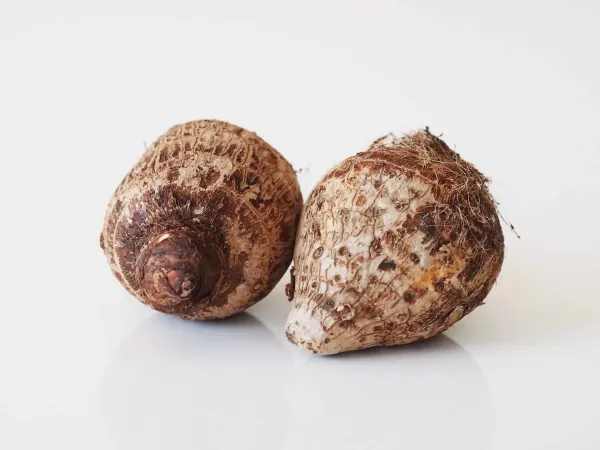Taro
Vegetable
Age Suggestion
6 months
Iron-Rich
No
Common Allergen
No

When can babies eat taro?
Cooked taro may be introduced as soon as baby is ready to start solids, which is generally around 6 months of age. The plant’s root and leaves are edible, but all parts must be cooked to reduce the risk of choking and remove toxins.
Warning
Raw taro root and leaves are toxic due to the presence of raphides (very small, needle-like oxalate crystals). Research has shown that thoroughly heat-cooking taro root and leaves is the most effective method of rendering them safe for consumption.
Where does taro come from?
Across the world’s tropics, this vegetable goes by many names, including chēmbŭ, cocoyam, dasheen, eddoe, gabi, kalo, khoai môn, kochu, saru, and taro—a loanword from the language of the Māori people. That one plant holds so many names hints at how long its starchy tubers and giant leaves have nourished people. Wild taro plants originated in the tropics of Southeast Asia, where humans learned to cultivate the plant long ago. Migration, trade, and colonization brought taro to Africa, the Americas, and the Mediterranean region. Now hundreds of varieties exist, some with pure white flesh and others speckled with pink or purple flecks. The name “taro” also applies to different species (such as malanga and ube), but the information here refers to Colocasia esculenta—the scientific name for taro.
Videos
Is taro healthy for babies?
Yes. Cooked taro root (also known as the corm) and leaves are loaded with essential nutrients. Never serve raw or undercooked taro, as it contains toxic compounds that can result in skin irritation, oral itching, and, in some cases, dangerous oral swelling when they are consumed. Thoroughly cooking the taro root and leaves makes them safe for consumption.
Taro root boasts plenty of carbohydrates to fuel baby’s rapid growth, as well as B vitamins (notably B6) for energy, vitamin E for immune support, potassium for nerve and muscle function, and fiber for digestive health. It also has a bit of calcium, iron, zinc, and vitamin C, in addition to prebiotics to support gut health. Taro also offers plenty of antioxidants to support the body’s resilience. Taro leaves contain lots of vitamin A and folate as well as some iron (though it’s not well absorbed unless coupled with other foods rich in vitamin C).
Taro flour is full of fiber, which can cause digestive upset when too much is consumed at once, so consider starting with a small amount in cooking and gradually increase as baby becomes accustomed to the food.
Deep-fried taro root (chips, fries, puffs, etc.) are not appropriate for babies because they present a choking hazard and can contain trans fats. Similarly, try to hold off on taro desserts until after the second birthday to minimize added sugar in the child’s diet.
★Tip: Use taro within a few days of purchase. Unlike potatoes, taro root does not keep long—even when properly stored in a cool, dark place. Generally, wearing gloves or oiling hands while handling taro root can help reduce skin irritation.
When can babies eat poi?
As soon as baby is ready to start solids. Poi is a preparation of mashed, cooked taro that is a popular food in the Pacific Islands. Serve fresh (sweet) or fermented (sour) poi in a bowl and let baby self-feed. If baby needs help, you can pre-load a spoon with a small amount of poi and pass the spoon to baby. Note that homemade fermented poi, like other fermented foods including yogurt or sauerkraut, can carry an elevated risk of foodborne illness.
Can taro help babies poop?
Yes. Taro offers excellent amounts of fiber and prebiotic resistant starches. Resistant starches “resist” typical digestion and instead, travel to the large intestines, where they nourish the body’s beneficial gut bacteria, promoting overall digestive health. These features, in combination with a balanced and varied diet, can help support overall digestive health and bowel regularity. Some research suggests that fermented poi, a mashed and cooked taro paste, is rich in probiotics that can help support the diversity of the gut microbiome.
Note that pooping patterns can vary significantly from child to child. Be sure to talk to your pediatric healthcare provider if you have concerns about baby’s pooping and digestive function.
Is taro a common choking hazard for babies?
Yes. Raw, hard vegetables are choking hazards, as they are challenging to chew. To minimize the risk, cook taro root until soft and finely chop the cooked leaves. As always, make sure you create a safe eating environment and stay within an arm’s reach of baby during meals. For more information on choking, visit our sections on gagging and choking and familiarize yourself with the list of common choking hazards.
Is taro a common allergen?
No. Allergies to taro are rare, but cases have been reported. Individuals with Oral Allergy Syndrome (also known as pollen food allergy syndrome), and in particular, those with sensitivities to tree or grass pollen, may also be sensitive to taro. Oral Allergy Syndrome typically results in short-lived itching, tingling, or burning in the mouth and is unlikely to result in a dangerous reaction.
As you would when introducing any new food, start by offering a small quantity of taro for the first few servings. If there is no adverse reaction, gradually increase the quantity over future meals.
Recommended Guide: Introducing Allergens
What are recipe ideas for cooking with taro?
Taro root can be used in any recipe that calls for potatoes, which means you can boil, grill, fry, roast, steam, or stew these starchy tubers with your favorite seasonings. You can also mash cooked taro root into a paste to make poi—a nourishing porridge from Hawai’i. Flour made from dried and pulverized taro root is increasingly available, so try it in taro buns, pancakes, dumplings, and more, or stir it into soups and stews to thicken the broth. When you have access to taro leaves, shoots, and stems, cook them like spinach or try your hand at making laing—a coconut and taro leaf stew from the Philippines. Regardless of the dish, make sure that taro roots and leaves are fully cooked before serving.
★ Tip: Preparing raw taro for cooking can cause the skin to itch because the plant contains calcium oxalate, a natural pesticide. To minimize the itchiness, wear kitchen gloves or rub your hands with oil before peeling the skin.
How do you prepare taro for babies with baby-led weaning?
Every baby develops on their own timeline, and the suggestions on how to cut or prepare particular foods are generalizations for a broad audience.
6 to 9 months old:
Offer peeled, cooked, and mashed taro root and let baby try to self-feed. Fresh (sweet) or fermented (sour) poi may be served at this age (but know that, as with other fermented foods like yogurt or sauerkraut, homemade fermented poi carries a higher risk of foodborne illness). Alternatively, offer cooked taro root cut into wedges about the size of two adult fingers pressed together. Chop cooked taro shoots and leaves to fold into egg dishes, mashed vegetables, grains, and other soft, scoopable foods. Avoid deep-fried taro (chips, fries, puffs, etc.) until after the second birthday to minimize the choking hazard. Same goes for taro desserts with added sugar or caffeine.
9 to 24 months old:
At this age, try serving cooked taro root cut into bite-sized pieces (about the size of a large adult knuckle), either on their own or in salads, soups, stews, and stir-fries. Or continue to offer larger wedges of cooked taro for practice with biting. You can also continue to serve poi and mashed taro, as well as finely chopped taro leaves that have been thoroughly cooked. Try offering taro dishes with bolder spices to introduce the child to the idea that foods can have different tastes depending on how they are prepared.
24 months and up:
Explore the wide range of recipes using taro—from savory stews like callaloo or laing made with cooked taro leaves, to steamed dumplings like kwacoco and wu tao gou made with cooked taro root. At this age, if you want to share halo-halo or other taro sweets with a toddler, offer a small amount in moderation.
For more on the best and worst foods for babies, see our First Foods Essentials bundle.
Written and reviewed by these specialists
J. Truppi, MS, CNS. Certified Nutrition Specialist®
V. Kalami, MNSP, RD, CSP. Board-Certified Pediatric Dietitian and Nutritionist
K. Tatiana Maldonado, MS, CCC-SLP, CBIS, CLEC. Pediatric Feeding Therapist
K. Grenawitzke, OTD, OTR/L, SCFES, IBCLC, CNT. Pediatric Feeding Therapist
S. Bajowala, MD, FAAAAI. Board-Certified Allergist & Immunologist (allergy section)
R. Ruiz, MD, FAAP. Board-Certified General Pediatrician & Pediatric Gastroenterologist
Expert Tips Delivered to Your Inbox
Sign up for weekly tips, recipes and more!
The content offered on SolidStarts.com is for informational purposes only. Solidstarts is not engaged in rendering professional advice, whether medical or otherwise, to individual users or their children or families. No content on this site, regardless of date, should ever be used as a substitute for direct medical advice from your doctor or your medical or health professional, nutritionist, or expert in pediatric feeding and eating. By accessing the content on SolidStarts.com, you acknowledge and agree that you are accepting the responsibility for your child’s health and well-being. In return for providing you with an array of content “baby-led weaning” information, you waive any claims that you or your child may have as a result of utilizing the content on SolidStarts.com.






